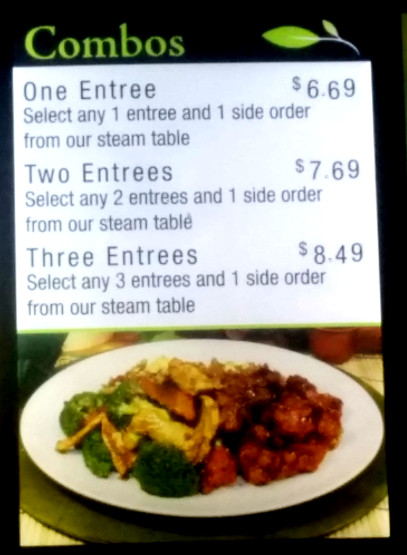Combo Pricing Gone Wrong
Saturday, October 15, 2016
Combo deals are all the rage these days. Businessmen have realized that product bundles are a great way to encourage potential customers to spend more money. After all, who wouldn't want to add a large container of fries and a coke for just a few dollars more?
Unfortunately, few marketers put much thought into how their combo deals are created. Many just package a random assortment of products together, pick a price that's somewhat lower than sum of the items' normal prices and hope for the best. Yes, some innovative companies utilize different bundling methodologies, but that's not to say that these adventuresome competitors perform any better.
Let's take a look at a bundle that I saw recently in Cambridge, Massachusetts.

There's plenty wrong with this combination offering.
For instance, the tier names are synecdoches (words that are used to define an item, but technically refer to only a part). I've rarely seen this naming strategy in use - and for good reason. In this case, each offering is named for the number of entrees included, but the side dish is completely ignored. In effect, the bundle names devalue the combination tiers by shielding a value-added component from customer consideration.
That said, let's focus in on the prices themselves. Any person armed with a basic knowledge of algebra, and a bit of time on his hands, is going to find something odd about the pricing on this menu.
Did you spot the oddity?
Let's break the menu down in table form:
| Combo | Price | Customer thought process |
|---|---|---|
| One entree | 6.69 | I have no idea how much each component is worth. Maybe the entree costs $5.69, and the side costs $1. |
| Two entrees | $7.69 | The 2nd entree costs $1.00, so entrees are worth $1.00 each and the side is worth $5.69. |
| Three entrees | $8.49 | Wait, entrees are worth 80¢ each, and the side is worth $6.09 |
Each addition to the combo meal effectively reduces the implied value of an entree while at the same time suggesting an increase in value for the side dish - an item that even the restaurant owner doesn't consider worth mentioning in the combo name.
Once a buyer has examined all of the combo offerings, he may wonder why the upper tier costs nearly $10 when it is composed of a mere trio of 80¢ offerings.
Prices should be used strategically to reach business objectives. Excluding decoy prices. It's very rare for a business to ever want to use pricing to devalue its offerings in the eyes of potential consumers.
Don't make the same mistake!
Do you have pricing questions for your business? Why not contact me for a consultation? Oh, and don't forget to grab a copy of my book on software pricing. It's not only a great read, but you can buy a bundle of two for exactly twice the price of one! How's that for a deal?